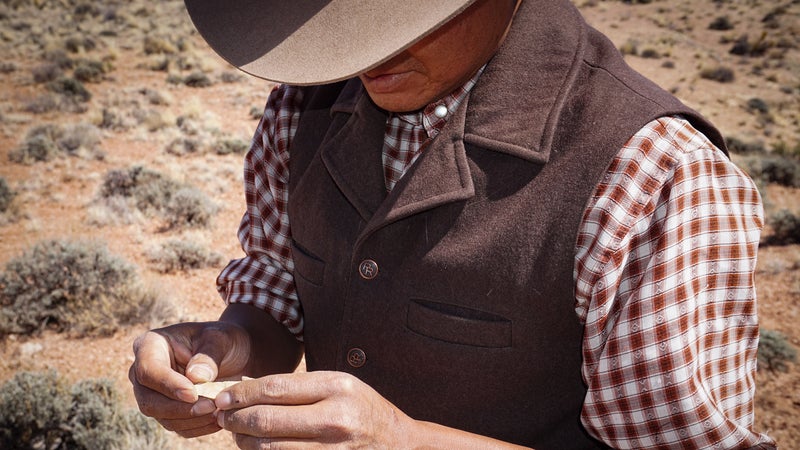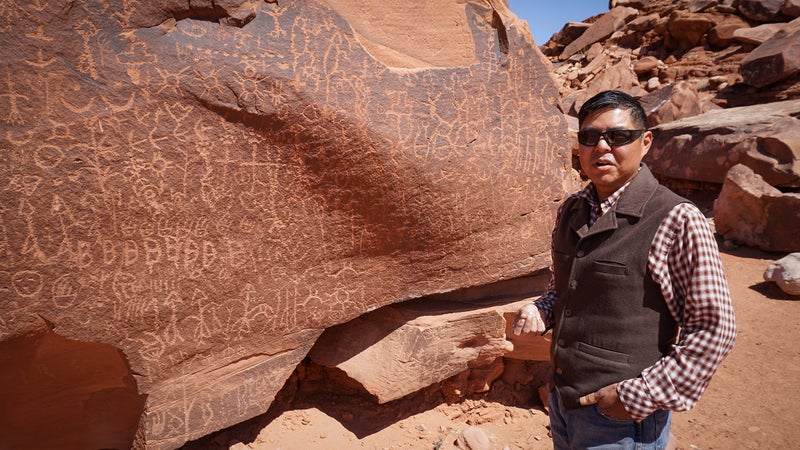The Native Americans Who Call the Grand Canyon Home
Jason Nez studies something that's too often forgotten amid the awe-inspiring views and canyon walls: those who live there
New perk: Easily find new routes and hidden gems, upcoming running events, and more near you. Your weekly Local Running Newsletter has everything you need to lace up! .
Jason Nez wears a wool vest, scuffed boots, and a look of total concentration. We’re on the remote eastern rim of the Grand Canyon in the Navajo Nation, where Nez has taken me to talk about archaeology. He pauses next to a yucca and picks up a small stone. One of its edges has been subtly sharpened into a cutting tool by a former resident of the area, perhaps 1,000 years ago. Holding it between his thumb and forefinger, Nez stoops to cleanly slice off a fistful of bunchgrass. “It’s been a while since anybody cut with that,” he says, dropping the tool where he found it.
For Nez, there is no clean break between prehistory and modernity, but a continuous human story that’s been unfolding on this landscape since the first hunters followed bison herds to the Grand Canyon’s rim roughly 11,500 years ago.
“You used to go to the [national] parks and there would be signs that said, ‘The mysterious Anasazi disappeared,’” Nez tells me. “We need to reeducate the world that Native people never left.”

Nez, who recently turned 40, grew up bouncing between an extended family on the western part of the near the Grand Canyon. Boyhood days rounding up lost sheep with his grandfather were his first career training. A skilled tracker, like a skilled archaeologist, reads stories told by traces on the land, Nez says. “If you let that landscape talk to you, it will. It will pull you. It will guide you. And Native people, we’ve been doing that for thousands of years.”
In 2003, Nez landed an interpretive job at and stayed for two seasons while studying environmental science in Flagstaff. After graduating, he heard a research team was excavating a prehistoric dwelling on the reservation. Nez visited the site out of curiosity and ended up joining the crew as an archaeological technician, screening buckets of dirt for small artifacts. He loved the work and was soon promoted to field director for other excavations. After seven years with the Navajo Nation Archaeology Department, Nez took a seasonal job (also as an archaeologist) in Grand Canyon National Park in 2011. More recently, he has worked as a fire archaeologist for the Park Service, helping fire crews protect cultural resources across the western United States.
Nez sees his Navajo heritage as one of his most important assets as a researcher, and he tries to “blend tradition and science” in the field. While working in the Grand Canyon, Nez has studied everything from 11th-century pueblos tucked under sandstone alcoves to the wreckage of a 1956 airplane collision that caused 128 fatalities and led to the creation of the . There are Native American clans who still live in the area and trace their lineage to the cliff dwellings. “The Grand Canyon isn’t just a canyon,” Nez says. “It isn’t just a river. The canyon is people, living people, out there right now on the Navajo, Hopi, Zuni, Hualapai, and Havasupai reservations.”

Nez swings his pickup into another turnaround and gets out. I follow him down rock ledges for 100 yards. All at once, the canyon opens before us. Three thousand feet below, the powder-blue streak of the travertine-rich Little Colorado River flows into the larger green Colorado.
Sitting on the rim, Nez tells me the legend of a Navajo hero named the Dreamer who once lived on the San Juan River in southern Utah. The Dreamer climbed into a hollow log one day and rode down the San Juan to the Colorado River and into the Grand Canyon. Nez says the Hopi have a similar story, and he’s convinced the legend was inspired by a historical person.
“So you don’t think John Wesley Powell was the first one to float the canyon?” I ask.
Nez smiles. “No way,” he says.


